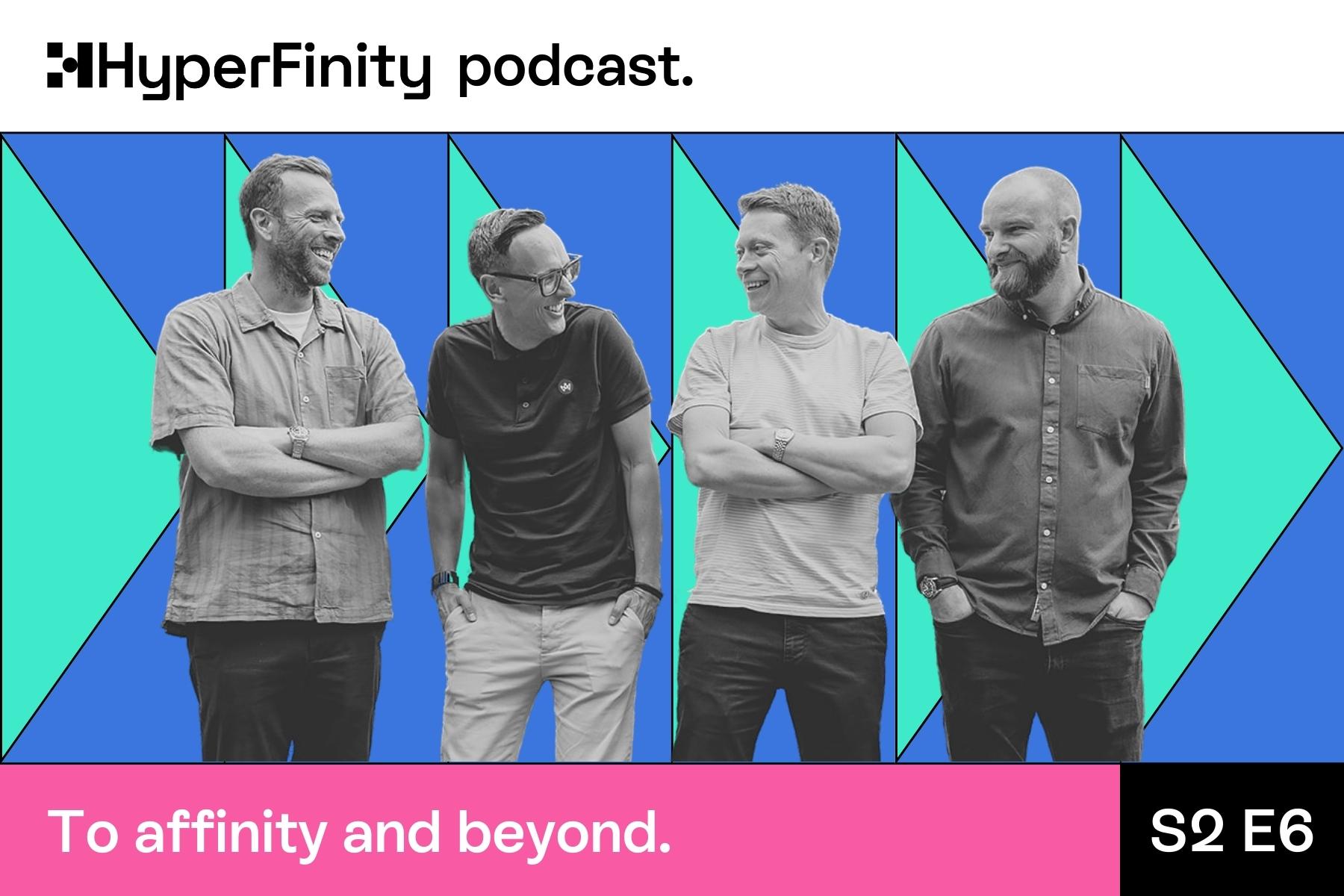Category:
Podcast
Series:
#2
Episode:
#6
Date:
March 2023
Stream on Spotify
Introducing Ed Child.
HyperFinity’s four co-founders have worked in data and tech for a number of years. Throughout those years, they’ve crossed paths with leading data evangelists – one such being Ed Child.
Ed worked with our CCO Peter Denby at what became TransUnion, and later worked alongside CDO Adam Barrowcliff, CTO Damon Bryan and CCO Thomas Hill at Asda.
He joined Costa Coffee two years ago as their Global Head of Consumer Data & Digital Analytics. Ed’s hugely passionate about using data and technology to build insights and actions to drive business transformation.
He’s a member of the Data IQ 100 for 2022, which recognises the most influential people in data.
Retaining customers is expensive.
Management thinker Peter Drucker’s definition of a business – to create and keep customers – is still true to this day. Retaining customers is key to business growth and success. In fact, research by Business2Company found existing customers spend 31% more than new customers and are 50% more likely to try new products. Meanwhile, HubSpot estimates it costs anywhere from 5 to 25 times more to acquire rather than retain customers.
Businesses investing in customer loyalty see a host of benefits, including reduced costs, boosted profits and a strengthened brand reputation.
One size doesn’t fit all.
Loyalty means many things to many people. For some, loyalty delivers financial rewards. For others, the benefits are convenience or a physical location. There’s also emotional loyalty, where consumers feel a certain affinity or connection with a retailer.
Loyalty schemes are a common way for retailers to develop an ongoing relationship with customers – improving engagement, retention and customer lifetime value.
The beauty of loyalty schemes? Retailers can personalise them to resonate with the right customers and audiences. Ultimately, it’s all about creating value – whether rewards are financial (e.g. a free drink), emotional (e.g. sneak peeks), or convenience-based (e.g. early access to sales).
Right customer, right time, right promotion.
The customer journey is growing ever more complex. Retailers can connect with customers through various channels – from live chat and social media to customer surveys and online advertising.
The key to loyalty is understanding customer behaviour and needs, then translating it into value. It goes back to that old market adage of right customer, right time, right promotion. For example, are customers driven by sustainability and ethics? Or are they more interested in speed and convenience?
If consumers choose to share their data with a retailer, they expect it to be used to deliver relevant experiences. Therefore, personalisation should underpin customer loyalty. Once retailers understand what consumers buy, they can use that customer loyalty data to personalise future transactions using data science techniques such as market basket analysis; next best product; substitute and complementary products; relevant upselling; predictive models; and segmentation.

There’s more to loyalty than personalisation.
Everyone jumps to personalisation, but customer loyalty data can power other business decisions:
- How can retailers make sure they’ve got the right products, the right pricing, the right range and the right propositions to suit the right consumers? Loyalty data is a great starting point. It provides a customer lens to help retailers really understand behaviour and needs. Retailers can reflect this insight back into their business through analytics, reporting and dashboards, powering informed commercial decisions. For example, what products should they sell? How should they price those products? Which products compete for the same demand? Where should physical stores be located? Which products are most suitable for a store in location X?
- There are subgroups within loyalty. It’s important to understand the value of different customers to make sure you’re acquiring more – whilst retaining your most loyal base. Loyalty data helps retailers segment consumers and understand why loyal customers return time and again.
Loyalty isn’t a crystal ball.
A word of caution: loyalty data cannot tell you everything about your customers. For example, it may be incomplete or inaccurate if customers forget their loyalty card, change bank cards, or use cash.
Retailers should also accept there will always be a large proportion of customers they don’t know much about – despite having a loyalty scheme. And loyalty customers tend to be inherently different to non-loyalty customers, from spending behaviour to adoption of tech.
However, customer loyalty data is a great directional tool – as long as you’re aware of its limitations.
Winner winner chicken dinner.
If you’re looking for inspiration, there are loads of great examples of customer loyalty schemes:
- Costa Club: Costa’s loyalty scheme was reintroduced in August 2021. Members receive a free ninth drink, plus a slice of cake on their birthday. The scheme appeals to consumers who value sustainability, by rewarding reusable coffee cup users with a free fifth drink.
- Tesco Clubard: Over 20 million households have a Clubcard – and it remains a key driver of loyalty for Tesco. In fact, 100% of UK promotions are via Clubcard Prices, which plays on consumers’ FOMO on great prices – a strong motivator to join the loyalty scheme.
- Boots Advantage Card: First launched in 1997, Boots pioneered using loyalty data to better understand customers and tailor offers to them. From May 2023, customers will earn 3p of points for every £1 spent. They’ll also save money on own-brand products and on Price Advantage offers.
- Asda Rewards: Asda rolled out its first app-based loyalty scheme in 2022. Customers can earn cash rewards by purchasing star products or achieving shopping milestones or missions.
- McDonald’s Rewards: Customers earn points for each penny spent to unlock rewards. The scheme also allows customers to donate points to selected charity partners. McDonald’s is aiming for the scheme to become “the world’s largest loyalty programme” and their CEO Chris Kempcziski cites loyalty as the “single biggest driver of digital adoption”.
- com Genius: Loyal customers can enjoy incremental discounts on accommodation across the world. In essence: if you book more hotels, you can access better prices.
- Amazon: Amazon doesn’t have an explicit rewards scheme, but it’s a great example of functional loyalty. Shopping with Amazon is convenient and the Prime subscription model means members return time and again.
Back to the future.
Loyalty needs to be simple and easy. In the future, it’ll probably seem alien for people carry around a wallet full of loyalty cards, or a phone peppered with loyalty apps. Instead, Ed predicts loyalty will happen automatically – via Apple Pay, Google Pay or your bank account.
Frictionless loyalty will be an interesting challenge for retailers – to make sure consumers feel real value from staying loyal.
Ultimately, loyal customers lead to business growth. Contact us to find out how decision intelligence can help you create better shopping experiences with your customer loyalty data.



